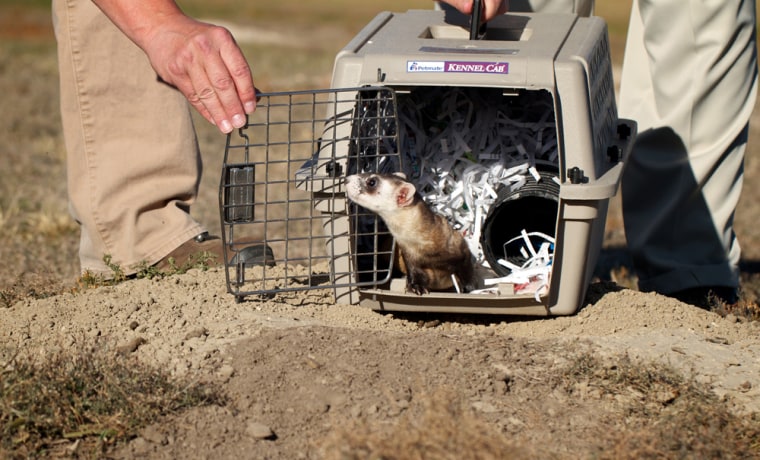As the cage door opened, black-footed ferret No. 7505 tentatively peeked his head out, looked hesitantly at the prairie dog burrow offered before him, and then rushed inside, disappearing beneath the earth of western South Dakota's badlands.
His freedom had been months in the making, but in less than a minute — and three decades after his species was believed extinct — he was gone, unleashed into the wild to do what the endangered ferret does best: attack and kill prairie dogs.
"Hopefully, he's chowing down on a prairie dog now," said Paul Marinari, a fish and wildlife biologist with the National Black-Footed Ferret Conservation Center.
The release was invitation-only event at the Badlands National Park, attended by about two dozen ferret fanatics, to kick off a weekend of nationwide festivities celebrating the 30th anniversary of the rediscovery of a mustelid once thought extinct.
On Sept. 26, 1981, a ranch dog in Meeteetse, Wyo., proudly presented his owners with a dead black-footed ferret. A local taxidermist identified the creature, which had been thought extinct for several years, launching a decades-long recovery effort that has seen the ferret population grow from 18 to more than 1,000 in the wild.
The ferret is still endangered, but conservationists are hopeful that by 2020, enough will be in the wild to wipe them off the list.
"We have a responsibility to restore a species that is very much a part of our North American heritage," said Kristy Bly, a wildlife biologist with the World Wildlife Fund. The recovery of the black-footed ferret — called BFFs for short — signifies the health of the grassland ecosystem, she added.
"We're committed to seeing this healthy, living prairie come back," Bly said.
The ferrets' decline is intertwined with the war waged on prairie dogs by farmers. Long considered farmland pests that compete with livestock for grass, prairie dogs have been hunted and poisoned en masse since the early 1900s.
The campaign worked. But as the prairie dogs disappeared, so, too, did their predators. Larry Haverfield, a cattle rancher in Logan County, Kan., said that loss wreaked havoc on the prairielands.
"Man poisons the prairie dogs, and that poison also kills some of the predators," he said. "You're shooting yourself in the foot."
Haverfield has allowed 7,000 of his 10,000-acre farm to host prairie dogs, irking his neighbors. In 2007, his land became one of just 19 recovery sites in the U.S., Canada and Mexico for the black-footed ferret, and 74 ferrets have since been released on his property.
They were born in captivity, then taken to 1,600-square-foot preconditioning pens where they're taught to hunt and feast on prairie dogs. The ferrets spend at least 30 days in the environment before they're released into designated reintroduction sites.
The recovery hasn't been without hiccups: Wildlife biologists had trouble at first mating the ferrets in captivity; they mate just once a year and have small litters of kits. Also, some swaths of the re-entry sites have been hit with canine distemper and the sylvatic plague, though newly introduced ferrets are vaccinated for both diseases.
Re-entry sites also are in Wyoming, South Dakota, Montana, Arizona, Colorado, Utah, Kansas and New Mexico. Several of the states have events scheduled throughout the weekend to celebrate the rediscovery's 30th anniversary, as do Illinois, Pennsylvania, Kentucky and Washington, D.C.
George and Kay Locatelli, of Fairfield, Calif., were giddy while meeting a captive ferret on display at the Ben Reifel Visitor Center in the Badlands National Park on Saturday morning. The ferret, named Mr. Brightside after a song by The Killers, curled up cutely in his aquarium for dozens of eager visitors.
"Hopefully, they're coming back for good," said Kay, 67.
Captive ferrets are given names; ones to be released into the wild are identified by number only, Marinari said.
To be considered officially un-endangered, the ferrets must have 10 separate populations of at least 10 acres with at least 1,500 breeding adults. Researchers are about one-third of the way there, said Bly, the wildlife biologist.
Just how to count the growing population is tricky, acknowledged Travis Livieri, executive director of Prairie Wildlife Research. Livieri works full time counting ferrets — a job done at night with a 100-watt bulb mounted atop his truck. The light reflects green in the nocturnal ferrets' eyes.
"Sometimes it's like spotting a needle in a haystack," he said late Friday on a so-called spotlighting count in the Badlands National Park. "You can be out here all night and not see a thing."
Bly said this weekend's nationwide ferret festivities are much deserved. It's about more than bringing back a species, she said. It's about saving the prairies.
"It's one key step to recovering this prairie," she said. "We're celebrating huge strides in the recovery effort."
___
On the Net:
Black-Footed Ferret Recovery Program and events marking 30th anniversary: http://www.blackfootedferret.org
